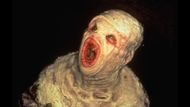Within dimly lit FBI offices and shadowy woods, The X-Files constructed a world in which the unexplainable was not only possible — it was all but waiting to be revealed. Created by Chris Carter in 1993, the show drew audiences into its supernatural realm, where ghostly forces lurked just beneath the surface of normal life.
At its center were two FBI agents: Fox Mulder (David Duchovny), a gifted profiler fixated on extraterrestrial abductions and dark conspiracies following the strange vanishing of his sister, and Dana Scully (Gillian Anderson), a medical doctor and no-nonsense skeptic assigned to keep him in line.
What distinguished The X-Files from everything else was how much it mixed the genres. It combined supernatural horror, science fiction, conspiracy thrillers, and procedural detective drama into something fresh and new. Each week toggled between sprawling "mythology" storylines — episodes ensnared in extraterrestrial conspiracies and government cover-ups — and heart-pounding "monster-of-the-week" stories that had everything from weird folklore creatures to creepy urban legends.
Aside from its twisting plots and disturbing imagery, the series addressed more profound fears famous in the '90s: Corruption at the highest levels, the fine line between faith and insanity, and the disturbing notion that science isn't always right.
It's look — dark cinematography, Mark Snow's creepy theme music, and eerily quotidian settings such as rain-soaked streets or moldy cellars — raised the bar for television atmosphere.
No surprise that The X-Files transcended cult stardom. It blew up into a full-fledged pop culture craze, giving birth to two feature films, comic books, video games, and an intensely devoted international fan base.
Its DNA can be seen all over subsequent series such as Lost, Fringe, and Stranger Things, and it continues to influence the way we narrate stories about the thin, vulnerable line between truth and lies.
Part of the show's enduring appeal lies in its gallery of monsters and villains. While the white "Greys" and the Cigarette Smoking Man personified grand conspiracies, it was frequently the more biologically realistic horrors — such as the sewer-dwelling Flukeman — that are most deeply into viewers' nightmares. These creatures turned mundane places into centers of terror, reminding us that sometimes the most terrifying dangers lie right beneath our feet.
Ultimately, The X-Files was always about the same spooky question: What if the truth is out there, but it is much darker — and much stranger — than we could have imagined?
"The Host": The X-Files episode that introduced the Flukeman

The Host, the second episode of The X-Files’ season 2, practically redefined TV body horror. This is the hour that introduced the world to the Flukeman, a hideous, parasitic mutant that crawled out of our worst nightmares and into pop culture legend.
It begins on a dirty Russian freighter drifting off the coast of New Jersey. The unluckiest of its crew is assigned the worst maintenance task possible: Unclogging the ship's dirty toilets. It is a great horror premise — dark, enclosed, unclean. As he works on the pipes, something down violently pulls him into the septic system. His screams reverberate through the claustrophobic metal corridors of the ship, and a mood of terror begins that is straight out of X-Files.
Days afterward, half of the crewman's corpse floats to the surface in the sewers of Newark. The police at the local level are perplexed, and it is odd enough to end up on the desk of an FBI agent who is already tired of dead ends.
By this point in the series, the X-Files division has been disbanded. Mulder's stuck on a case he believes is pointless — he is convinced Assistant Director Skinner is demoting him to sewer duty as punishment. Feeling disillusioned and stuck, Mulder even confesses to Scully that he is considering leaving the Bureau.
Scully consents to conduct the autopsy. She learns two key pieces of information:
A Russian-language tattoo on the arm of the man, referencing the freighter's origin.
A huge fluke worm is embedded in the victim's liver.
It is a disturbing discovery that immediately raises the case from bizarre to outright terrifying.
The sewer attack: The Flukeman bites again

In Newark, a sanitation worker, Craig, is attacked by whatever is in the sewer. He manages to survive, thinking he was bitten by a giant snake. But when the wound is seen by a doctor with Mulder in attendance, it is obvious this is no ordinary animal bite — it is a weird, four-tined mark no one can account for.
Soon after, Mulder gets a cryptic telephone call from an unseen informant, warning him that someone within the FBI is still monitoring his activities. The short exchange sows the seeds of "X," the enigmatic figure who will be the center of the show's larger mythology.
The actual horror occurs later that evening. While showering, Craig begins violently coughing… and vomits up a live fluke worm. Mulder's search eventually leads him to a sewage treatment plant, where he meets a foreman named Ray. That's where they finally meet the horror itself: The Flukeman. A human-sized beast with pale, leech-like flesh and a round, sucker-mouthed face filled with teeth — a monstrous hybrid of man and giant parasitic worm.
Meanwhile, in her laboratory, Scully pieces together the science behind the horror. Examining flukeworms found in Craig's body, she understands that the Flukeman isn't merely feeding — it is attempting to breed by infecting human hosts.
The odd bite marks precisely correspond to the creature's mouth, and the larvae within the victims confirm it is a living incubator. This clinical, cold description only makes the horror more real.
Why "The Host" remains outstanding in The X-Files legacy

By the end of the episode, The X-Files has presented one of its most indelible hours, combining urban grime, folkloric horrors, and uncannily credible science into a story that is gross and fascinating.
As Mulder and Scully connect the dots, the episode suggests a spine-tingling back story. The Flukeman is perhaps the product of radioactive mutation connected to Chernobyl — an aftereffect of ecological cataclysm.
It draws on 1990s fears of nuclear pollution, genetic mutation, and the somber underside of human technological achievement. The show's creator, Chris Carter, has claimed to have drawn on actual worm research, Chernobyl fallout, and wider fears of species extinction.
Finally, after multiple attacks, Mulder and local officials manage to capture the Flukeman alive. Mulder insists that “this is not a man; it’s a monster,” but Skinner requests a complete psychiatric evaluation.
The episode turns darkly comedic when Flukeman makes his escape by crawling into a portable toilet. A tank cleaning crew accidentally vacuums it into a sewage tanker truck the next morning and shoots it back out into the sewers. Realizing that Flukeman is still on the loose and bound for the sea (where it would multiply unfettered), Mulder and the sewage plant supervisor run to an overflow pipe.
In a tense, swampy confrontation, the foreman loses his glasses and is attacked, prompting Mulder to plunge into the dirty water to rescue him. When the Flukeman attempts to flee through a pipe, they crush a heavy gate across it, cutting the creature in two in a bloody, water-soaked ending.
Aftermath and implications: Are there more Flukemen?

"The Host" closes on a frighteningly open-ended note. Even when the Flukeman is gruesomely sliced in half, there is a creepy feeling that this could be only the beginning. The show leaves audiences with the spooky possibility that there might be more creatures like it out there — or that cycles of contamination and mutation might be going on, hidden, beneath our feet.
This ambiguity is part of what makes the Flukeman so haunting. It is not just about the terror of one monster lurking in the sewer — it is about what else might be out there. The real horror lingers in the notion that nature, once twisted by human negligence, can breed nightmares we are powerless to stop.
The Flukeman explained: Anatomy and design of The X-Files’ most disturbing monster

Of all the hideous monsters to emerge from The X-Files, the Flukeman ranks among the most unforgettable — and repulsive. A hideous amalgamation of human and parasitic flatworm, the creature's body is structured to inspire maximum discomfort on all fronts:
Humanoid body: The Flukeman walks and gestures like a man, but its slippery, mottled flesh is unnatural, reminding one of worms or amphibians yanked from dark, damp spaces.
Circular mouth: Its defining characteristic is a sucker mouth with sharp, inward-facing teeth — an anatomical reference to actual flukeworms, which invade organs.
Reproductive behavior: Compelled by a drive to reproduce, it infects human hosts with larvae, recalling the disturbing life cycles of parasitic flatworms in the wild.
Radioactive origins: The episode heavily suggests that this animal might be the result of radioactive mutation, possibly Chernobyl-related, to fuel 1990s anxiety over genetic contamination and unregulated pollution.
Breathing life into Flukeman was an achievement in special effects. Special effects sorceress Gillian G. created the suit, while Darin Morgan (who would go on to be a renowned X-Files writer) spent hours trapped within it. They built a monster that was not just physically revolting but also embedded itself in audiences' subconscious anxieties.
